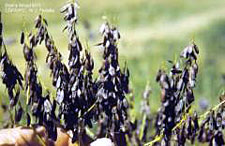| Reference Library > Noxious Weeds > Noxious Weeds of Northeastern California | ||
|
Noxious Weeds of Northeastern California |
||
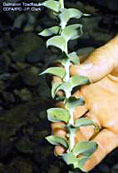 Dalmatian toadflax has several crowded blue-green waxy leaves that are broad at the base, narrowing towards the tips, and alternating up the stem.� |
The invasive species problem Within the last century, large numbers of extremely damaging plants have been introduced into and have become established in the United States. Invasive plants have spread at an alarming rate because, unlike native species, there are very few native insects, fungi, or diseases to control their growth and spread in this country.�The origin of invasive weeds range from accidental, such as weed seed contamination of commodities, to purposeful, such as purple loosestrife and other plant species introduced as ornamental plantings.� While many introduced plants are non-invasive and even quite beneficial to society as garden ornamentals or as agricultural crops, a large number of introduced plants are now considered invasive weeds.�Regardless of the mode of entry or purpose of these introductions, the public has suffered economic losses to food and fiber production, deterioration of natural resources (rangeland and wildlands, forests, aquatic and riparian habitats), loss of native species and their habitats, and further economic losses due to restrictions on the export of pest-contaminated commodities (Mullen et al. 2000). Invasive weeds destroy wildlife habitat and forage, threaten endangered species and native plants, increase erosion and groundwater loss, and hinder recreational activities. |
|
|
|
||
| Some Important Invasive or Noxious* Weeds of Northeastern California | ||
| * Noxious weeds are invasive weeds that have been designated as pests by law or regulation.� They are usually weeds that are of particular harm to agricultural lands or other commercial land uses (e.g. forestry).�There are federal and state noxious weed lists.� A third list has been developed that covers invasive weeds not considered "noxious" by the previous definition, but are significant problems in wildland situations where they threaten the diversity of California's native flora and fauna.� This list has been established by CalEPPC (the California Exotic Pest Plant Council.
Unless otherwise noted, all photos are from the California Department of Food and Agriculture |
||
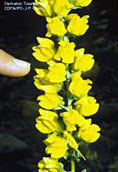 The flowers of Dalmatian toadflax resemble snapdragons in appearance. |
Dalmatian Toadflax (Linaria genistifolia (L.) Miller ssp. dalmatica (L.) Maire & Petitm.)(CDFA list: A*).� Also known as broad-leaved toadflax, and wild snapdragon, L. dalmatica. Description � A perennial herb that grows up to 2m tall.� Seeds germinate in the fall producing low growing stems which then bolt in the spring.� Its has several crowded blue-green waxy leaves that are broad at the base, narrowing towards the tips, and alternating up the stem.� Bright yellow flowers emerge from the axils of the leaves through the summer.� These flowers resemble snapdragons in appearance with a distinctive spur and orangethroat.� Flowers range from 1.5 � 3.5cm in length.� The upright stems die back in late fall. Location � In California Dalmatian toadflax is spreading but not yet common in the Great Basin and desert regions, and there is concern that this species will continue to spread throughout northeastern counties. Origin � Southeastern Europe Impacts - Dalmatian toadflax is most commonly found along roadsides, fences, range lands, croplands, clear cuts, and pastures.� It is very competitive with other plants for soil moisture.� It is able to establish dense colonies which then aggressively displace desirable plant species and reduce the value of rangeland. Reproduction -� Both by seed and creeping roots.� Seeds can survive in the soil up to 10 years. Control methods - The Nature Conservancy Wildland Invasive Species Team Additional information |
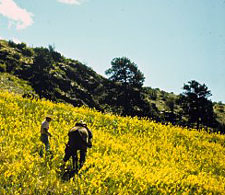 Toadflax is able to establish dense colonies which then aggressively displace desirable plant species and reduce the value of rangeland. |
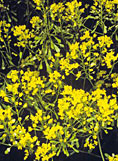 Flowering of dyer's woad occurs from late spring to early summer. |
Dyer’s Woad (Isatis tinctoria L.� CDFA list: B*).� Also known as marlahan mustard. Description � A winter annual, biennial, or short lived perennial that exists as a basal rosette.� The flowering stem emerges from this rosette and can reach a height of 1.2m (48 inches). Flowering occurs from late spring to early summer.� Seed matures approximately 2 months after flowering and then germinates in fall and early spring.� The leaves are bluish-green and have a distinctive white midvein (from 3-18 cm long, 1-4 cm wide).� The inflorescence consists of many small yellow flowers that form a flat top. Location � Dyer’s woad can be found in the Klamath Ranges, Cascade Range, North Coast Ranges, northern & central Sierra Nevada, Modoc Plateau, northern San Francisco Bay region; to Oregon, Montana, Utah. To 1000 m (3300 ft). Origin � Native to Europe. Impacts � Dyer’s woad was traditionally utilized in Europe as a medicinal herb and sourceof blue dye.� Foliage contains compounds that may have insecticidal and fungicidal properties.� It is found along roadsides, fields, disturbed sites, railroad rights-of-ways, and forests.� It can spread into cropland and rangeland by seed.� It forms a thick tap-root that allows this plant to regenerate after mechanical removal.� Reproduction -� By seed. Control methods - Weber County Weed Abatement Additional information |
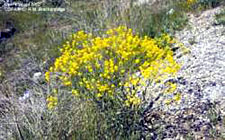 Dyer's woad is found along roadsides, fields, disturbed sites, railroad rights-of-ways, and forests. |
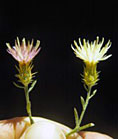 Flowering heads of diffuse knapweed develop from July through October and are white to purplish in color (petals 12-13mm long). |
Diffuse Knapweed Centaurea diffusa (CDFA list: A*) Description � This plant is an herbaceous biennial, sometimes annual to triennial. This plant typically germinates after the first fall rains and develops into a basal rosette.�Once it has bolted in late spring/early summer, the stems become widely or “diffusely” branched and reach up to 0.8m in height.�The lower leaves are finely divided and upper leaves are entire. Flowering heads develop from July through October and are white to purplish in color (petals 12-13mm long).� Reduced leaves (involucre bracts or phyllaries) subtend the flowerheads.� These phyllaries have green comb-like teeth tipped with a spine. Diffuse knapweed can form a deep taproot.� Old stems are persistent. Location � In California, diffuse knapweed exists up to elevations of 2300m (7500ft) primarily in the northern part of the state, particularly in the northeast. Origin � Southeast Eurasia. Impacts -� Invades pastures and rangelands, roadsides, and waste areas.� It is considered highly competitive and allelopathic. Reproduction � By seed. Control/Additional information - The Nature Conservancy Photos � King County Natural Resources and Parks Noxious Weed Identification and California Department of Food and Agriculture |
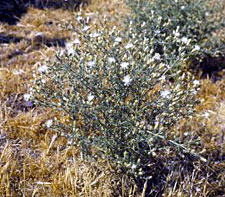 Diffuse Knapweed invades pastures and rangelands, roadsides, and waste areas. |
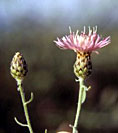 Flowerheads of spotted knapweed develop at the end of branches and are white, pink, or purple in color (sometimes cream colored). |
Spotted Knapweed Centaurea maculosa. (CDFA list: A*) Description - This plant is an herbaceous biennial to short lived perennial that typically germinates after the first fall rains, develops into a basal rosette and bolts in the spring/summer, eventually growing up to 1m in height.� It has a stout taproot.� Basal leaves are narrow and range from entire to divided.� Upper leaves are mainly divided.� Flowerheads develop at the end of branches and are white, pink, or purple in color (sometimes cream colored).� Phyllaries subtend the flowerheads and have dark comb-like teeth.� Flowers are present from summer through fall.� Seeds have pappus bristles. Location � Similar distribution as diffuse knapweed, but with the addition of the south end of peninsular ranges. Origin � Europe Impacts � Invades disturbed soil and has become a major rangeland weed in other states (Montana).� It vigorously competes with desirable plant species for soil moisture and nutrients, and may be allelopathic. Reproduction � By seed and by roots (vegetatively).� Up to 40,000 seeds can be produced by one plant.� Vegetative reproduction can also occur from lateral roots that spread through the soil profile, giving rise to new shoots. Control/ Additional information - The Nature Conservancy Photos - California Department of Food and Agriculture and The Nature Conservancy |
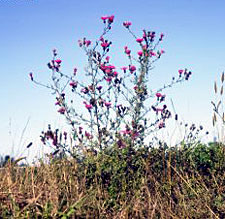 Up to 40,000 seeds can be produced by one spotted knapweed plant. |
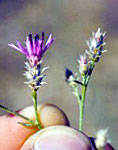 Small rose or pink flowerheads emerge throughout the summer (July � August) and produce few (3-4) seeds (petals 7-9mm long). |
Squarrose Knapweed Centaurea squarrosa. (CDFA list: A*) Description � This highly branched perennial starts off as a basal rosette that typically germinates after the first fall rains, develops into a basal rosette and bolts in the spring/summer, later reaching up to 0.5m in height.� The lower leaves are deeply divided and the upper leaves are very reduced (bract-like) or entire.� Small rose or pink flowerheads emerge throughout the summer (July � August) and produce few (3-4) seeds (petals 7-9mm long).� Green or straw colored phyllaries subtend the flowerheads, are reflexed or spreading, and contain a spine. Location � In California, squarrose knapweed it is currently only located in the northern most counties (i.e. Humboldt, Siskyou, Trinity, Shasta, Modoc, Lassen, and Plumas) up to 1400m (4600ft) in elevation. Origin � Asia Impacts � Squarrose knapweed invades degraded rangelands and is adapted to cold temperatures and drought, is highly competitive with desirable plant species, and may be allelopathic. Reproduction � By seed.� The seedheads fall off the plant and disperse seeds soon after the seeds mature in the late summer. |
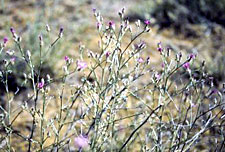 The seedheads of squarrose knapweed fall off the plant and disperse seeds soon after they mature in the late summer. |
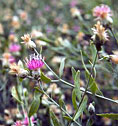 Russian Knapweed is thought to be allelopathic and can cause chewing disease in horses (nigropallidal encephalomalacia). |
Russian Knapweed Acroptilon repens. (CDFA list: B*) Photo from The Nature Conservancy web link noted below* Description � This perennial weed typically germinates after the first fall rains, develops into a basal rosette, bolts in the spring/summer, and grows up to 1m in height.� Stems grow very dense, erect, and are heavily branched.� Lower leaves are deeply lobed.� Upper leaves are narrow and entire.� Pink to lavender flowers that emerge through the summer and early fall are contained in a cone-shaped flowering head that is located on the branch tips.� Light green to white phyllaries subtend the flowerheads, are without spines, and have papery margins.� Mature underground stems or rhizomes are dark brown to black in color.� Stems dies back in the late summer. Location � Russian knapweed populations exist in most counties in California up to 1900m (6200ft) in elevation except for Calaveras, Del Norte, El Dorado, Humboldt, Mariposa, Mendocino, Sierra, and Trinity Counties. Origin � Central Asia. Impacts � It invades cultivated sites, fields, orchards, vineyards, pastures, roadsides, and waste places.� This plant is thought to be allelopathic and can cause chewing disease in horses (nigropallidal encephalomalacia).� Persistent underground stems make this plant difficult to control.� Reproduction � It spreads primarily vegetatively by underground stems that can reach depths greater than 8ft.� Root pieces are able to resprout forming new infestations.� Viable seeds are produced but only in small quantities. Control - The Nature Conservancy Additional information
Photos - California Department of Food and Agriculture and The Nature Conservancy |
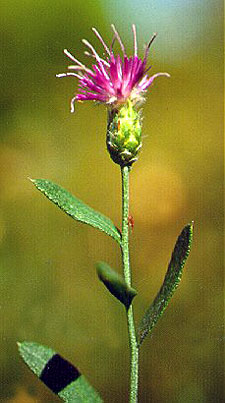 Pink to lavender flowers of russian knapweed emerge through the summer and early fall and are contained in a cone-shaped flowering head that is located on the branch tips. |
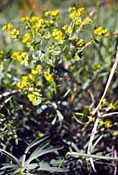 Flowering of leafy spurge occurs from June through July and seeds are produced approximately one month after flowers emerge. |
Leafy Spurge (Euphorbia esula L. (CDFA list: A and CalEPPC list: A2*).� Also known as faitours-grass, wolf’s milk, Euphorbia virgata, Euphorbia discolor, Euphorbia gmelinii, Tithymalus esula, and Galarrhoeus esual. Description � Perennial herb up to 0.8m tall.� The leaves are long and smooth and are from 2-6cm in length and 0.5cm in width.� They are arranged alternately along the thickly clustered stems. All parts of the plant contain a distinctive white sap.� Clusters of small greenish flowers are subtended by heart-shaped green bracts.� Roots can reach 9m in depth in addition to spreading horizontally throughout the soil. Leafy spurge seeds germinate primarily in the spring but continue to germinate throughout the summer and fall.� Flowering occurs from June through July and seeds are produced approximately one month after flowers emerge.� Stems die back in the fall. Location � In California, leafy spurge is found primarily in the northeastern portion of the state up to 1400m (4,600ft) in elevation. Origin � Southwestern Europe. Impacts � This plant invades waste areas, disturbed sites, roadsides, fields, pastures, rangelands, alfalfa fields, and riparian areas.� It comtaminates forage, decreases desirable plant species, decreases the quality of rangelands, and may be toxic to both humans and animals that come into contact with the milky sap.� The roots of this plant grow extensively and are able to tolerate cold weather and drought, making control difficult. Reproduction � Abundant seed producer (up to 250 seeds per stalk) and vegetative propagator. �Seeds likely initiate infestations and can persist in the soil for up to 8 years.� Vegetative reproduction occurs from buds on the roots that can develop new shoots and are responsible for expansion of a population once present in an area. Control - The Nature Conservancy Additional information - Photos - California Department of Food and Agriculture and The Nature Conservancy |
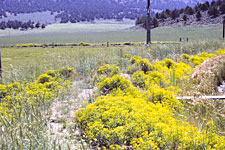 Leafy spurge comtaminates forage, decreases desirable plant species, decreases the quality of rangelands, and may be toxic to both humans and animals that come into contact with the milky sap.� |
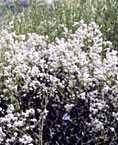 Perennial pepperweed forms a rosette initially, then stems elongate, flowers are produced, and seeds develop by late spring through summer. |
Perennial Pepperweed (Lepidium latifolium L.)(CalEPPC: A1 and CDFA list: B*).� Also known as: tall whitetop, giant whiteweed, perennial peppergrass, slender perennial peppergrass, broad leaf or broad-leaved peppergrass, ironweed, and Virginia pepperweed. Description - Perennial pepperweed is an herbaceous perennial that can grow up to 1.5 meters in height.� The leaves are green to gray-green in color with basal leaves larger than upper leaves.� The root system is rhizomatous.� Small white flowers form a panicle. Stems emerge from perennial roots from spring to fall.� Perennial pepperweed forms a rosette initially, then stems elongate, flowers are produced, and seeds develop by late spring through summer.� In mid- to- late summer, plants senesce.� Old stems can remain for several years and can develop a dense layer of thatch. Location � Perennial pepperweed can be found in all counties in California except Humboldt, Del Norte, Imperial, and San Bernadino Counties. Origin - Southeastern Europe and southwestern Asia. Impacts - Perennial pepperweed is considered highly invasive in a large range of moist to wet habitats including riparian areas, wetlands, marshes, and floodplains. It can also invade roadsides, native hay meadows, alfalfa fields, and rangeland habitats. It forms dense stands that exclude other vegetation (including native plant species), degrades wildlife habitat, displaces threatened and endangered species, and its persistent perennial roots make removal and control of the species very difficult. Reproduction - Primarily by underground perennial roots that spread and generate new shoots in the early spring.� On riverbanks, perennial pepperweed roots break off, travel to new sites of invasion via water, and develop shoots. Control -�The Nature Conservancy Additional information � California Department of Food and Agriculture |
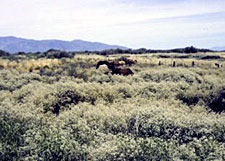 Perennial pepperweed is considered highly invasive in a large range of moist to wet habitats including riparian areas, wetlands, marshes, and floodplains. |
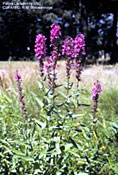 Rose-purple flowers of purple loosestrife form long racemes or spike-like clusters of flowers.� Flowers bloom from mid-June through September and stems die back each year. |
Purple Loosestrife (Lythrum salicaria L.). (CDFA list: B*).� Also known as purple lythrum, bouquet-violet. Description � A rhizomatous perennial that has square, erect stems and can grow up to 2.4m (8ft). Its leaves, 5-14cm long, are arranged opposite from eachother or whorled around the stem.� Rose-purple flowers form long racemes or spike-like clusters of flowers.� Flowers bloom from mid-June through September and stems die back each year. Location � Populations have been noted in the following counties: Butte, Central Coast, Fresno, Humboldt, Nevada/Placer, Mendocino, Kern, Sacramento-San Joaquin, Delta, Siskiyou, Shasta, Sutter/Yuba, and Yolo counties up to 1000m (3300ft). Origin � Native to Europe. Impacts �� Purple loosestrife was originally planted as a medicinal herb that has now escaped cultivation and is a noxious weed.� It grows in moist or marsh areas and can invade streambanks or shorelines of shallow ponds.� Infestations form dense mats that hinder water flow in canals and ditches.� Purple loosestrife is suspected of reducing wildlife habitat.� Established plants can tolerate dry conditions for portions of the year. Reproduction - Primarily by extensive roots that create a dense mat above and below ground that chokes out other plant life. Control methods -
Additional information - Distribution -� |
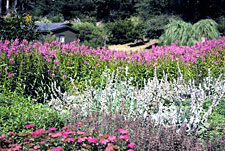 Purple loosestrife grows in moist or marsh areas and can invade streambanks or shorelines of shallow ponds.� Infestations form dense mats that hinder water flow in canals and ditches. |
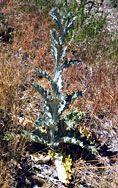 Stems of scotch thistle have spiny wings and leaves are deeply lobed, spiny, and covered with dense white hairs which give them a grey appearance. |
Scotch thistle (Onopordum acanthium L. ssp. Acanthium) (CDFA list: A*).� Also known as cotton thistle, winged thistle, woolly thistle, jackass thistle, and heraldic thistle. Description - "Scotch thistle is an herbaceous biennial that can grow up to 1.5 mtall.� Stems have spiny wings and leaves are deeply lobed, spiny, and covered with dense white hairs which give them a grey appearance."� (Whitson 2000).� Flowers are violet to red in color and are 1-2 inches (3-5 cm) in diameter. Seeds germinate in the fall and form a rosette in the spring.� In the second year, plants bolt in the spring, flower in the summer, and produce seed by late summer or early fall. Location - In California, Scotch thistle populations are rare but can become large where established.� Scotch thistle can be found in many areas throughout California but the bulk of the infestations occur in the northeastern part of the state. Origin - Southern Europe and the Mediterranean area through Asia. Impacts - Scotch thistle can become established in vacant lands, natural areas, disturbed sites, heavily grazed areas, roadsides, fields (dry soils along flood plains), especially on sites with fertile soils.� In rangelands, it forms dense stands of very spiny foliage that can become impenetrable to livestock.� Seeds can live longer than 20 years in the soil thus making control of the weed very difficult. Reproduction - Only by seed; many seeds are produced that can live more than 20 years. Control/Additional information � Invasivespecies.gov Distribution � |
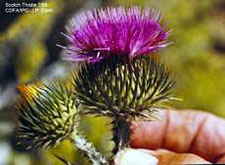 Seeds of scotch thistle can live longer than 20 years in the soil thus making control of the weed very difficult. |
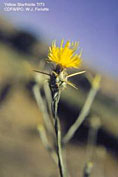 Spiny yellow flowers of yellow starthistle are located on the tips of spreading branches. |
Yellow Starthistle (Centaurea solstitialis L)(CalEPPC: A1 and CDFA list: C*).� Also known as golden starthistle, yellow cockspur, and St. Barnaby’s thistle. Description - Yellow starthistle is a blue/green annual that can reach 1 m in height, has winged stems covered with white hairs and entire, pointed leaves.� Leaves near the base of the plant are deeply lobed.� Spiny yellow flowers are located on the tips of spreading branches. Seeds germinate primarily in the fall and can continue germinating with rain events throughout the summer.� Rosettes form in the spring, and flowering occurs in the late spring early summer.� Seeds are dispersed in late summer/early fall. Location � Common in California below 1800 m (6000 ft), but has been found up to 2600m (8600ft).� Uncommon east of the Sierra Nevada. Origin � Southern Europe. Impacts � Yellow starthistle is considered one of the worst rangeland weeds in California.� It has spread in California very quickly covering an estimated 10-12 million acres of the state.� It invades open areas on roadsides, rangeland, wildlands, hay fields, pastures, and waste areas.� Yellow starthistle contaminates grain, reduces forage quality in rangelands, and vigorously competes with and displaces other plant species.� By depleting soil moisture, threatening both native annual grasses and forbes.� It can also cause chewing disease (nigropallidal encephalomalacia) in horses (leading to death). Reproduction - By seed.� Up to 100,000 seeds can be produced by a large plant.� Seeds can persist in the soil for up to 3 years. Control - For an extensive review of the biology, ecology, and management methods used for yellow starthistle, see the following web site: Weed Research and Information Center - yellow starthistle page. Additional information - University of California Statewide Integrated Pest Management Program Photos � California Department of Food and Agriculture and The Nature Conservancy |
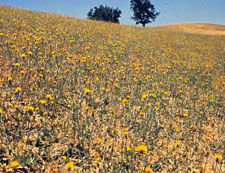 Yellow starthistle is considered one of the worst rangeland weeds in California. |
